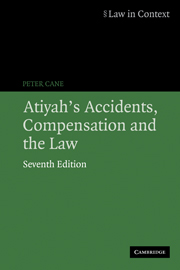Book contents
- Frontmatter
- Contents
- Preface
- List of abbreviations
- List of tables
- Table of legislation
- Table of cases
- Part One The Issues in Perspective
- Part Two The Tort System in Theory
- 2 Fault as a basis of liability
- 3 The scope of the tort of negligence
- 4 Departures from the fault principle
- 5 Causation and remoteness of damage
- 6 Damages for personal injury and death
- 7 An appraisal of the fault principle
- Part Three The Tort System in Operation
- Part Four Other Compensation Systems
- Part Five The Overall Picture
- Part Six The Future
- Index
6 - Damages for personal injury and death
Published online by Cambridge University Press: 05 June 2012
- Frontmatter
- Contents
- Preface
- List of abbreviations
- List of tables
- Table of legislation
- Table of cases
- Part One The Issues in Perspective
- Part Two The Tort System in Theory
- 2 Fault as a basis of liability
- 3 The scope of the tort of negligence
- 4 Departures from the fault principle
- 5 Causation and remoteness of damage
- 6 Damages for personal injury and death
- 7 An appraisal of the fault principle
- Part Three The Tort System in Operation
- Part Four Other Compensation Systems
- Part Five The Overall Picture
- Part Six The Future
- Index
Summary
The lump sum: predicting the future
Personal injury cases
Damages for personal injury and death typically take the form of a lump sum. The award or settlement is made once for all, and there is – except in rare cases – no possibility of increasing it or decreasing it later because of changes in the claimant's situation. In the great majority of instances where the injuries are relatively minor, this raises no real problem because the injured person is likely to be completely recovered long before the damages are assessed, and the whole episode is by then past history.
However, the lump–sum remedy does raise acute problems wherever a person suffers serious injuries, the effects of which may still be felt long after the damages are assessed. The Pearson Commission estimated that about 7.5% of all tort claims (including claims in fatal cases) involved future earnings losses after the trial or settlement of the claim; and this is the type of claim that raises problems with lump sums. In cases of continuing income loss, or where the injured person will have a continuing need for hospital, medical or nursing care, two sets of predictions have to be made at the date of trial or settlement in order to calculate an appropriate sum. First, it is necessary to predict what would have happened to the injured person if they had not been injured, a prediction which obviously cannot be verified or falsified by subsequent events.
- Type
- Chapter
- Information
- Atiyah's Accidents, Compensation and the Law , pp. 130 - 174Publisher: Cambridge University PressPrint publication year: 2006

